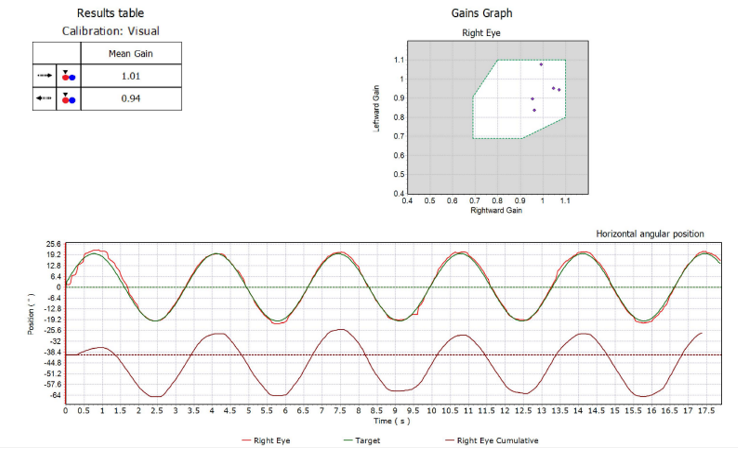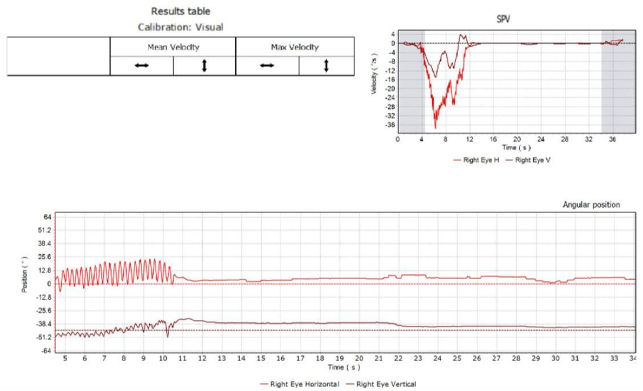Question
What are the different protocols in ocular motor testing, and how do they help manage patients with vertigo?
Answer
Video-nystagmography (VNG) is essentially an advanced method for examining eye movements. This article will cover some key protocols tested during VNG:
- Saccades
- Smooth Pursuit
- Optokinetic Testing
- Spontaneous Testing (With or Without Fixation)
- Gaze testing (With or Without Fixation)
- Nystagmus Evaluation
- Head Shaking Test
- Hyperventilation Test
1. Saccades
Saccades are quick eye movements that shift your focus from one point to another, helping you quickly change what you're looking at. The main purpose of saccades is to move objects of interest onto the fovea, which is often first detected by your peripheral vision. These movements are also used to scan something complex, like a painting. Attention is crucial when examining saccades.
In clinical practice, saccadic testing, especially horizontal saccade testing, examines how the brain decides when and where to move your eyes and how the brainstem executes that movement. With videonystagmography equipment, doctors can identify issues in the cerebellum or brainstem that manifest as saccadic dysmetria, which is key in differentiating central from peripheral causes of vertigo.

Figure 1. The graph of normal horizontal saccades recorded by the Inventis VNG model Plus – for NYSTALYZE wireless.
The Inventis VNG model Plus provides key details about saccades, such as their latency, precision, and velocity, which are extremely helpful for diagnosis. In simple terms, the latency of saccades measures how well the pre-motor pathways (the cortical or subcortical pathways that initiate saccades) are functioning. The velocity indicates the performance of the brainstem and ocular motor nerves, while the precision reflects the integrity of the cerebellum or its pathways.
2. Smooth Pursuit
The pursuit system allows your eyes to smoothly follow moving objects. This system relies on neural circuits that extend from the visual cortex to the cerebellum. The main trigger for smooth pursuit movement is retinal slip. The Inventis VNG system can detect various issues such as saccadic intrusions, reduced gain, and catch-up or catch-back saccades. These abnormal pursuit movements, assessed through horizontal and vertical smooth pursuit testing with videonystagmography, can indicate central processing disorders.

Figure 2. The graph of normal horizontal smooth pursuit (0.3 Hz) recorded by the Inventis VNG model Plus – for NYSTALYZE wireless.
3. Optokinetic Testing
Optokinetic reflexes are activated when you're viewing large, moving visual scenes, engaging both the smooth pursuit and saccadic systems. Optokinetic testing, which can be performed horizontally and vertically using videonystagmography equipment, provides data on how these eye movements work together and their compensatory mechanisms. Performance in optokinetic testing can reveal if there are any central processing abnormalities.

Figure 3. The graph of normal horizontal optokinetic response (20 deg/s) recorded by the Inventis VNG model Plus – for NYSTALYZE wireless.
4. Spontaneous Testing With and Without Fixation
Examining spontaneous eye movements in light (with fixation) and in darkness (without fixation) can help identify nystagmus, skew deviation, or other issues. The ability of visual fixation to suppress these unwanted eye movements can indicate whether the problem is peripheral or central. The precision of the videonystagmography equipment is crucial for detecting the subtle movements that suggest vestibular dysfunction.


Figure 4. Spontaneous testing Without Fixation (left) and With Fixation (right) performed using the Inventis VNG model Plus – for NYSTALYZE wireless.
Center gaze testing assesses how well the eyes can maintain focus when looking straight ahead. Fixation plays a significant role in controlling spontaneous nystagmus, with central mechanisms being more effective at suppressing vertical and horizontal nystagmus than the torsional component. The results from spontaneous testing are crucial for a thorough vertigo diagnosis.
5. Gaze Testing With and Without Fixation
In addition to visual fixation, eye movements can be influenced by gaze positions. Gaze-evoked nystagmus, detected through the Inventis VNG, is characterized by nystagmus that appears or increases when a patient looks in cardinal gazes, i.e., horizontally and vertically. It can originate from either central or peripheral sources and provides significant insights into the directionality and potential causes of a patient's vertigo.
6. Nystagmus Evaluation
Nystagmus is defined as involuntary, rhythmic, and oscillatory eye movements with at least one slow phase. With 47 different types identified, its analysis involves understanding the attributes of nystagmus (trajectory, direction, conjugacy, frequency, amplitude, and reference frames of eye movements), allowing localization of dysfunction to the peripheral vestibular apparatus, brainstem, cerebellum, anterior visual pathways, or cerebral hemispheres.
There are several provocative tests used to elicit or modify spontaneous nystagmus. The following is a list of various provocative tests that can be employed during VNG testing:
- Positional Testing
- Head Shaking Test
- Sound-Induced Testing
- Valsalva Testing
- Pressure-induced Testing
- Vibration-Induced Testing
- Hyperventilation-Induced Testing
7. Head Shaking Test
The head shaking test, though often underutilized, is highly informative for revealing unilateral vestibular disease. By inducing head movements, clinicians can use the Inventis VNG model Plus to detect post-head shaking nystagmus. This can be pivotal in identifying vestibular asymmetry and guiding the diagnosis of vertigo etiology.

Figure 5. Head Shaking Test with a normal graph performed using the Inventis VNG model Plus – for NYSTALYZE wireless.
8. Hyperventilation Test
The hyperventilation test (HVT) induces metabolic changes that can disrupt partially compensated vestibular asymmetry, thereby unmasking latent vestibular dysfunctions. Its utility is demonstrated by its ability to reveal hyperventilation-induced nystagmus (HVIN) across a spectrum of vestibular disorders, ranging from peripheral to central.
Incorporating these precise assessments into a VNG examination framework facilitates a nuanced approach to diagnosing vertigo. The ocular motor tests, conducted with sophisticated videonystagmography equipment, enable clinicians to uncover objective evidence of vestibular system integrity, aiding in the accurate diagnosis and tailored management of vertigo in affected patients.
Resources for More Information
- Discover our solutions for vestibular analysis on our website: https://www.inventis.it/en-na/solutions/balance-unique-solutions
- Check out the following courses published on AudiologyOnline:
- Don't miss the interviews on AudiologyOnline:

